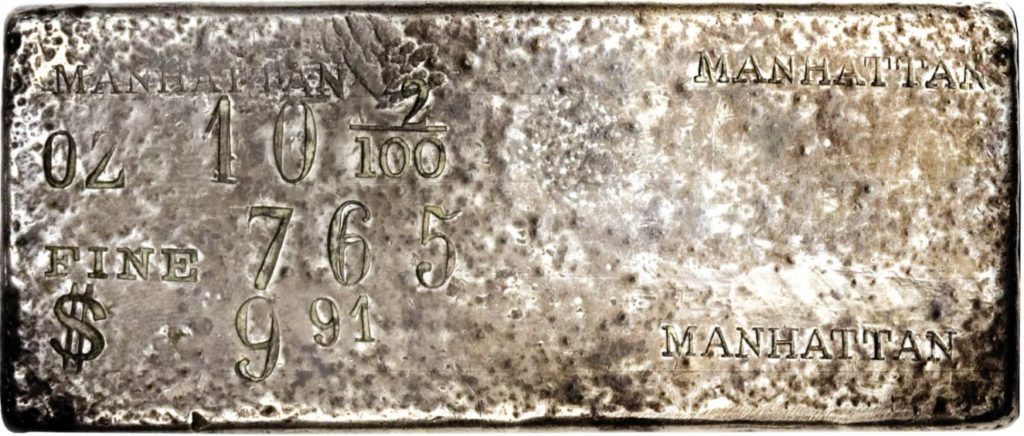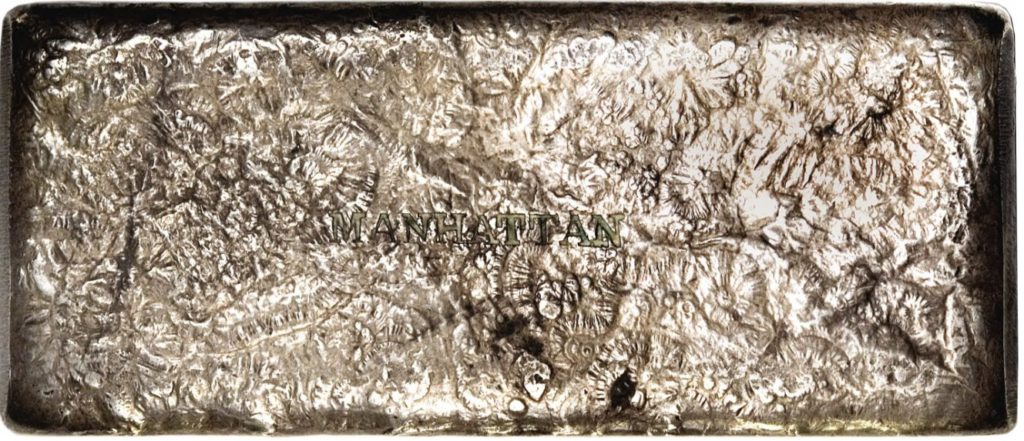10.2 oz, $9.91 Enigmatic Manhattan Silver Ingot

Manhattan Silver Ingot. This description and opinion was written by Fred Holabird. The Manhattan silver bar is punched “Manhattan” on the reverse, and “Manhattan” punched three times on the obverse, 10 2/100, 765 Fine, $9.91. There are no assay chips. The bar has been filed on both ends longitudinally at the reverse edge.

It is difficult to render an opinion about this ingot. As a result, we will discuss the positive attributes, as well as certain things which are out of the ordinary. None of these things, either separately, or in conjunction with each other, are enough for me to render an opinion within a 95% realm. Many ingots that are seen today are different from the norm. As research into the field deepens, avenues that were once considered closed, suddenly open with great reason. Thus scientists must keep their minds open when ingots of this nature surface, particularly when the obvious is not apparent.
Often specific ingot attributes are simply a commonality of the person or company policy punching the markings. Certainly all of the Kellogg-Humbert ingots of the S.S. Central America and successor companies punched their ingots similarly. The same holds true for assayers such as Conrad Weigand of San Francisco and Virginia City, as well as H. Harris. This ingot displays some characteristics that we have seen in ingots from the Reese River period. But it also has things that are atypical.
Positive attributes:
The punch patterns on the ingot show strong similarities to other ingots of the early period, particularly the period circa 1868-1879. Specifically, the OZ, FINE, and dollar sign are consistent with other bars.
The word “Manhattan” is a single gang punch. This is typical of any mining company punch, especially those who regularly produced ingots.
Inconsistencies:
Few original ingots have filed or shaved ends. What purpose can this attain?
Few original ingots carry the mine or company name more than once on a side. The only possible explanation for this if it is original, is that it was used for display or “Exhibition” purposes.
Few original ingots have the mine or company name punched on both sides.
There is no assay chip or chips. The lack of these could be due to the nature of the ingot, if it were used as an exhibition ingot.
Discussion of the Source of the Word Manhattan.
At first glance, a professional mining person would think it might mean the Manhattan Silver Mining Company. This was one of the most important silver mining companies of central Nevada. But I would expect to see the initials “S. M. C.” after the word Manhattan, and these are clearly not present. It should be noted that the Manhattan Silver Mining Company carried that specific name. It was not the Manhattan Company, or any other shortened version. Why? Because the company was not formed around a rich mine by the name of Manhattan, but because the company was formed by a rich group of financiers in New York City (on the isle of Manhattan) who had missed out on the opportunities of the Comstock. When the Reese River Rush started in 1863, and mines were found on Lander Hill above Austin, Nevada that year, mining commenced on a large scale. But underfinanced, the tiny mining companies needed capital, and the New York financiers were only happy enough to oblige.
Thus, the Manhattan Silver Mining Company was formed in 1865 as one of the first funded by New York financiers, and they proceeded to buy up as many of the silver mines on and near Lander Hills as money could buy. These included the Florida and other rich mines. By 1870, the Manhattan SMC had built the largest mill in the region, and reduced ores for other mining companies on a custom basis. They had more than 100 workers by the next year. The company lasted until 1887, when it sold at a Sheriff’s sale for nothing. The succeeding company, the Manhattan Company, failed in less than a year, and the third successor company was the Manhattan Mining & Reduction Company. It sold to the Austin Mining Company in 1891, in another of a long string of successors.
The question becomes, is this ingot from one of the successor companies, that regularly just used the word “Manhattan?” It does not appear to be from the Manhattan SMC because that company appears to have always used the Silver Mining Company initials (SMC) in all of their documents, thus it is natural to assume they would have used the same slogan or company moniker on any ingot that came from the company.
If the ingot is from the short-lived Manhattan Company (1888 only), it makes sense that they would only use the single word. It also makes sense that they might punch the word all over the face (three times) to show the validity of the product in the face of an insecure financial market in New York City, while possibly on display at one of New York’s brokerage offices accompanied by rich ore specimens. The ore specimens from Austin, particularly some of the rich mines such as the Florida, are extant in the Mackay School of Mines (a.k.a. Keck) Museum on the campus of the University of Nevada Reno.
None of these samples, rich in native silver, have been analyzed for their metal content. The ores were often exhibited. At the Paris Universal Exhibition of 1867, the ores of Austin were noted as “They are remarkable for their richness in silver and absence of gold.” Copper was the usual other metal, along with antimony. Since no gold is accounted for on the face of the ingot, as would be expected if the ingot were from the Comstock, or other region where gold was a common natural byproduct, it must be assumed that it is from copper or another minor metal of insignificant value at the time.
The ores of Lander Hill were notable because they occurred as a different type of ore deposit from other silver deposits around the west. The Comstock, and most other silver-gold systems in the west, occur in highly altered volcanic rocks. Austin has silver in quartz veins cutting plutonic (intrusive) rocks. The veins were generally thin (less than a few feet wide), and did not last with increased depth. As a result, their value decreased over time as they were mined out. The Comstock, and other better developed hydrothermal systems, boasted ores to depths of well over a thousand feet. An early map of the district is found in Ross Raymond’s Mineral Resources of the States and Territories West of the Rocky Mountains, published in 1869 with an internal data base of 1868.
If this is the source of the silver in this ingot, the only way to determine it is by testing the metallic fingerprint of this ingot and comparing it to reduced ores and subsequent ingots from later-mined specimens from Lander Hill where the Manhattan Company had its operations for that brief period in 1888.
Other Mines With the Name Manhattan
In 1868, the rush to White Pine was on. Rich silver chloride ores were found about 100 miles east of Austin, and it was quickly called the next Comstock. A claim was filed and a mine dug on property the man called “Manhattan,” clearly named after the company of the same name in Austin. Here they dug a shaft of over 100 feet by 1869 on silver chloride ore. 25 men worked the mine, and more still worked the company’s 20-stamp mill. Is this the source of the ingot? The only way to tell is to metallurgically test this ingot with ores reduced from this mine.
Other mines named Manhattan existed over the years, most of them so named to take advantage of the success of the original Manhattan Silver Mining Company of New York. Among the others are (from 1882 alone) the Manhattan in Pinal County Arizona, the Manhattan in Piute County Utah, among others. The Arizona mine was mostly gold. The Utah property was also silver-copper.
Summary
In summary, rendering an opinion on this ingot without proper metallurgical testing is almost impossible. It has all the appearances of coming from the Manhattan property from 1888, but could just as well come from another property of the same name from some other western mining district.
On the other hand, while a forger could make such a bar with relative ease, why go to this trouble to duplicate so many attributes, then shave off the ends of the bar?
At this point, I would place the legitimacy of the bar at over 60% in favor of legitimate. But the location is still speculative. The ingot itself is darkly patinated silver and measures 85 x 35 mm. In addition to the three MANHATTAN punches on the top side, there is another in the center of the back side. As mentioned above, the back side appears to have been evenly shaved on the short ends, giving it a beveled appearance.
[05/2007] https://coins.ha.com/itm/ingots/manhattan-silver-ingot-this-description-and-opinion-was-written-by-fred-holabird-the-manhattan-silver-bar-is-punched-man/a/434-2440.s ($1,725)
